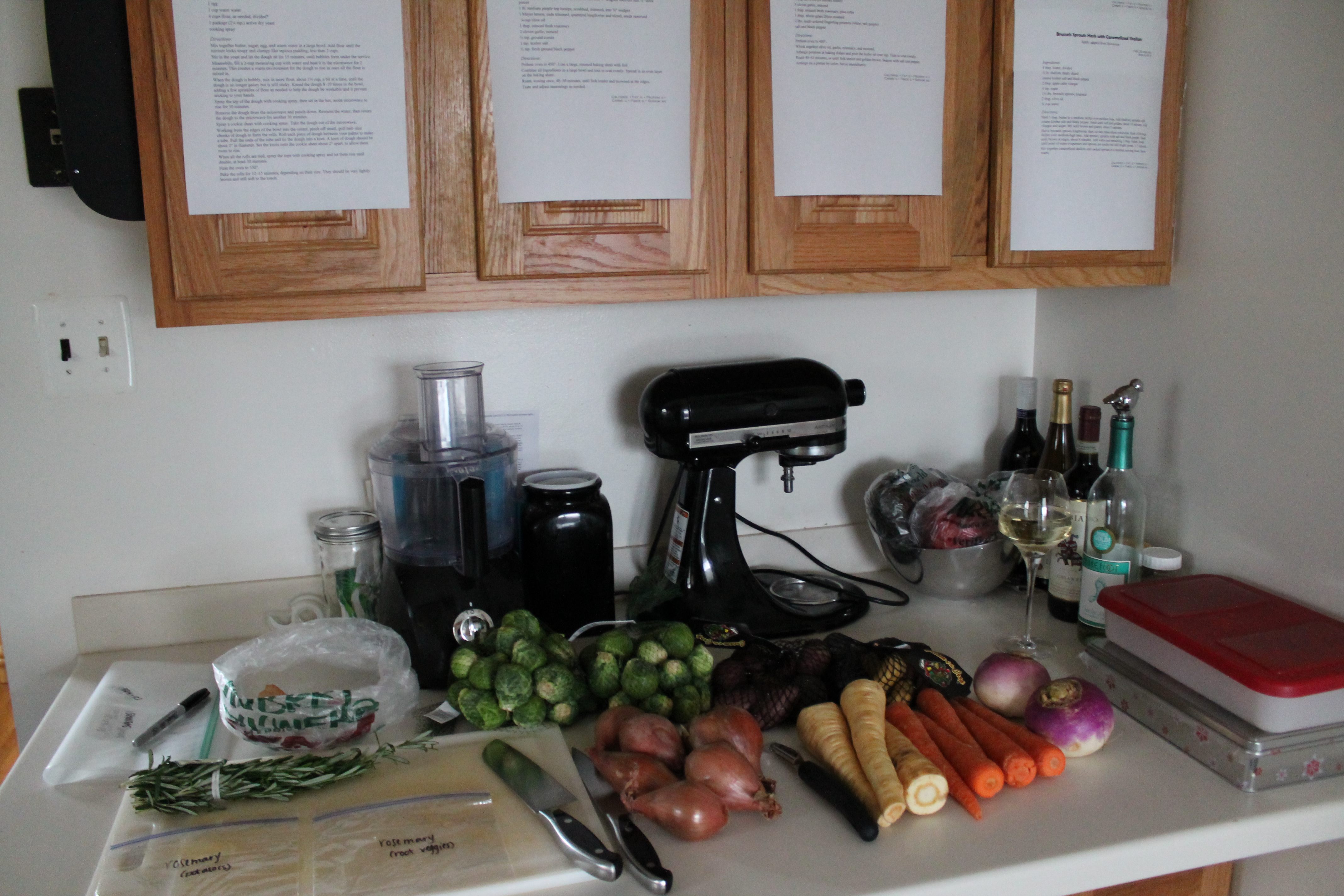This afternoon, as I was awkwardly stuffing the contents of four sacks of groceries into my fridge, it occurred to me that we haven’t really talked about Christmas dinner.
That’s partly because the entire first half of this month was a blur for me, as I spent it organizing and cooking for a multi-day party in the Outer Banks for my husband’s 30th birthday. Dave requested mostly meaty Asian foods (pho, moo shu, pad ka pow), which I made from scratch (no mixes of any kind!)…and then sat back and ate cookies while dinner was served. The main attraction was about 50 board games, which Dave and most of his friends and family proceeded to play for three days straight. It was a lot of work, but it turned out totally awesome!
And I learned something extremely valuable from feeding 20 people for three days: preparation is everything.
This is a lesson that really should be extended to all events, especially holiday feasts! Because, honestly, the last thing you want is to be running around frantically on what should be a day for family time and celebration.
Whether you are hosting Christmas breakfast or dinner, throwing a dinner party, or just bringing one dish to a potluck, planning—and doing—ahead will make your special feast relaxing and fun. So pour yourself a glass of wine, turn on your favorite Christmas music, and let’s get to work!
So this year, for Christmas dinner, our menu is:
cider-glazed salmon (so grateful to my husband, who suggested freely that I skip making a land critter this year so we could all enjoy the same food for the holiday meal!), from A Homemade Life
roasted root veggies with meyer lemon, from Fine Cooking Magazine, December 2012
rosemary-garlic fingerling potatoes, from A Year of Holidays
brussels sprouts with caramelized shallots
and my Grandma’s knotted rolls
Not to mention dessert, which will hopefully be bûche de Noël!
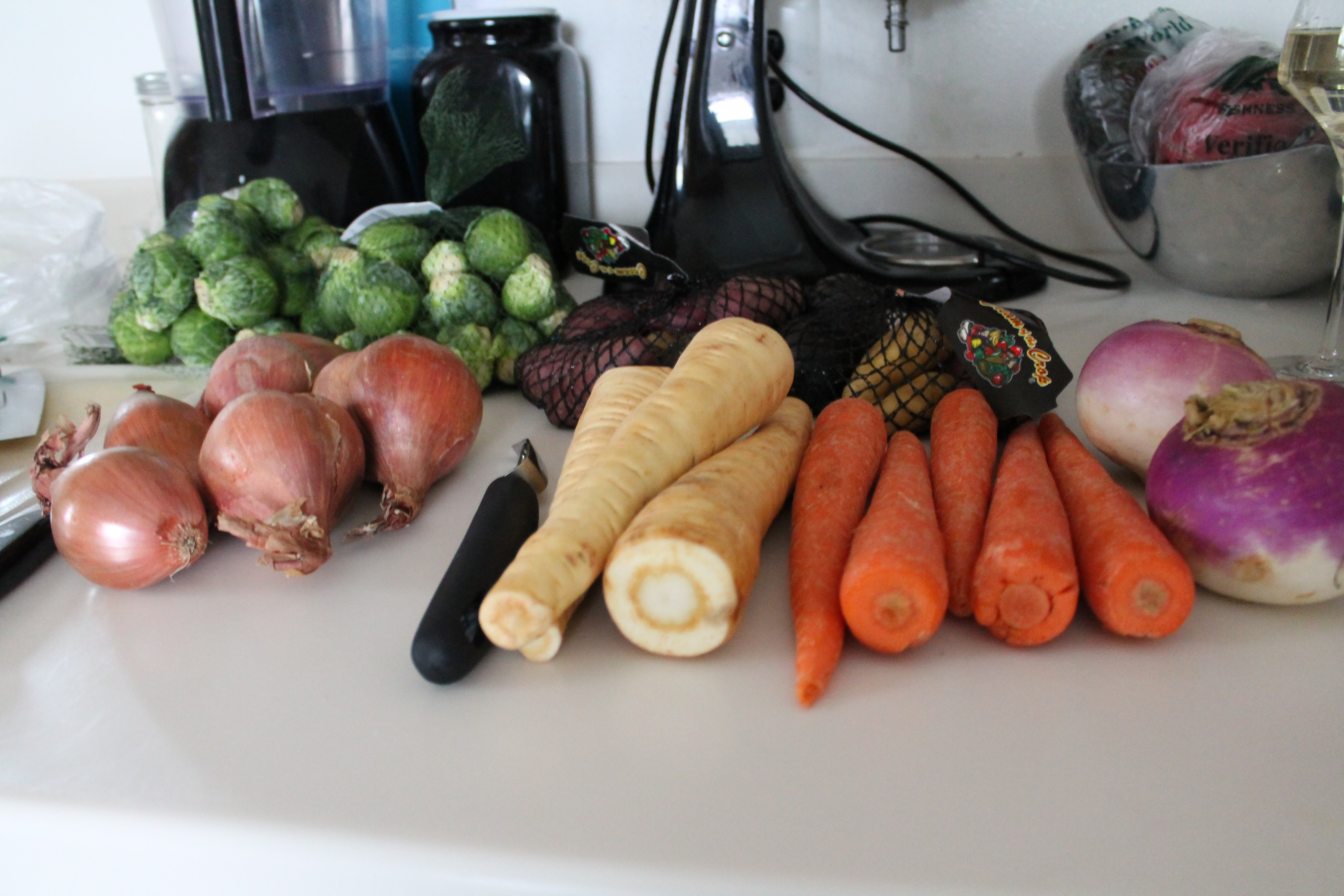 I strongly believe in eating vegetables for holiday meals. And all meals. Go figure. (Also, potatoes don’t count, as they are nutritionally more like a carb.) If you came to eat at my house, it would be a cold day in June before you’d find a meal that consisted of meat, potatoes, and bread. I think it’s so worth it to feed yourself a multicolored meal! But, though fresh veggies are great (often tastier and more nutritious than frozen, and definitely superior to canned), they generally require a lot more hands-on effort than a hunk of meat or a ready package.
I strongly believe in eating vegetables for holiday meals. And all meals. Go figure. (Also, potatoes don’t count, as they are nutritionally more like a carb.) If you came to eat at my house, it would be a cold day in June before you’d find a meal that consisted of meat, potatoes, and bread. I think it’s so worth it to feed yourself a multicolored meal! But, though fresh veggies are great (often tastier and more nutritious than frozen, and definitely superior to canned), they generally require a lot more hands-on effort than a hunk of meat or a ready package.
That’s why a low-stress holiday dinner should always involve doing as much work as possible before the main event.
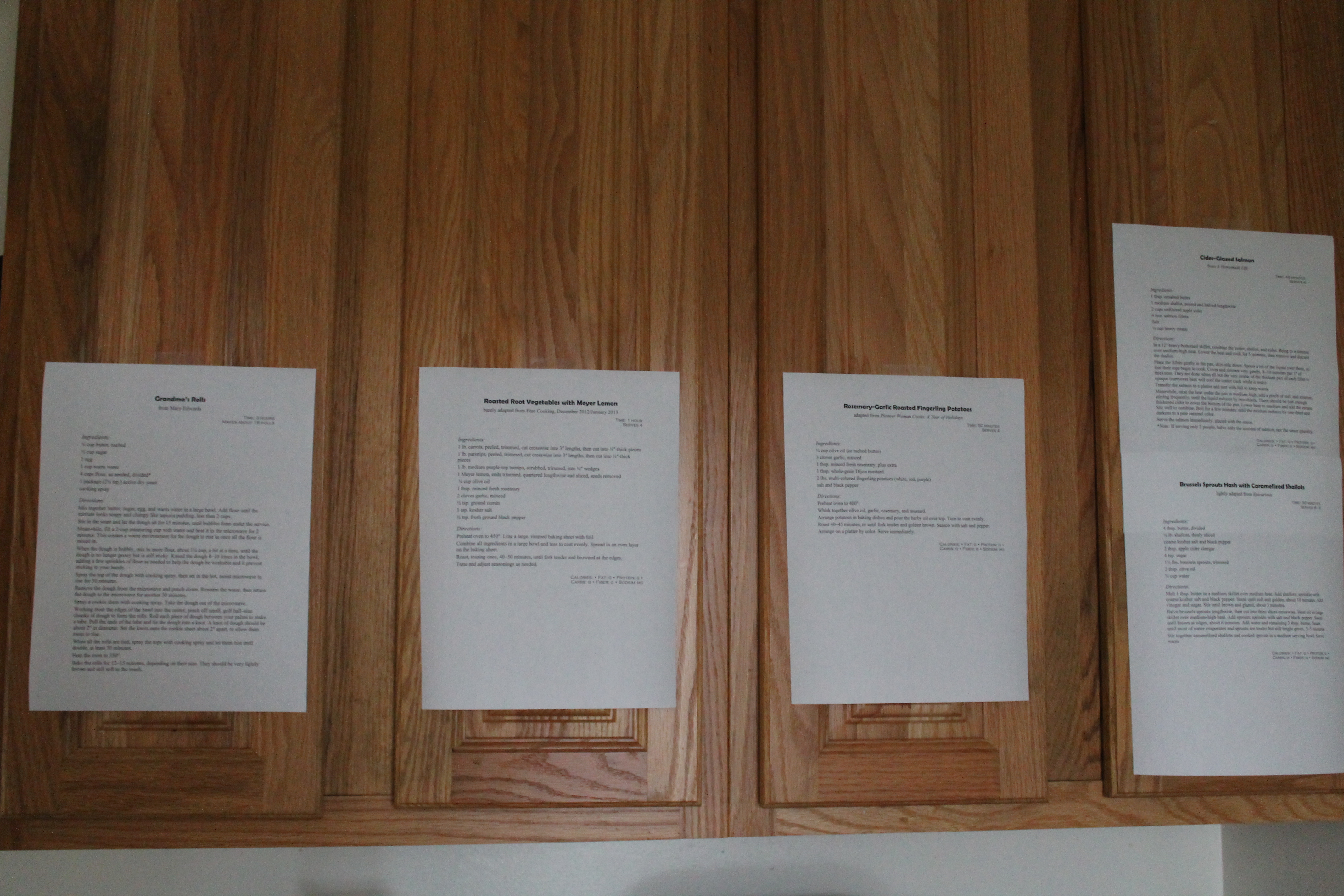 The first step is to collect your recipes all in one place. I recommend writing out even the simplest recipes; you want to make absolutely sure you haven’t forgotten anything, and you don’t want to be scrambling around at the last minute. I like to tape my recipes to the upper cabinets above my workspace, at about eye level. That way, I am not blocking any counter space, and I can easily see everything. I also like to tape them up in the order I think I will be working on each dish, which just helps me think through my schedule on the big day.
The first step is to collect your recipes all in one place. I recommend writing out even the simplest recipes; you want to make absolutely sure you haven’t forgotten anything, and you don’t want to be scrambling around at the last minute. I like to tape my recipes to the upper cabinets above my workspace, at about eye level. That way, I am not blocking any counter space, and I can easily see everything. I also like to tape them up in the order I think I will be working on each dish, which just helps me think through my schedule on the big day.
Please read the recipes as you collect them and arrange them! Make sure you have in your head a good idea of how everything should come together and what each ingredient’s function is. Also, please take note of how and how long each dish needs to cook, especially those that will be competing for space in the oven or on the stove.
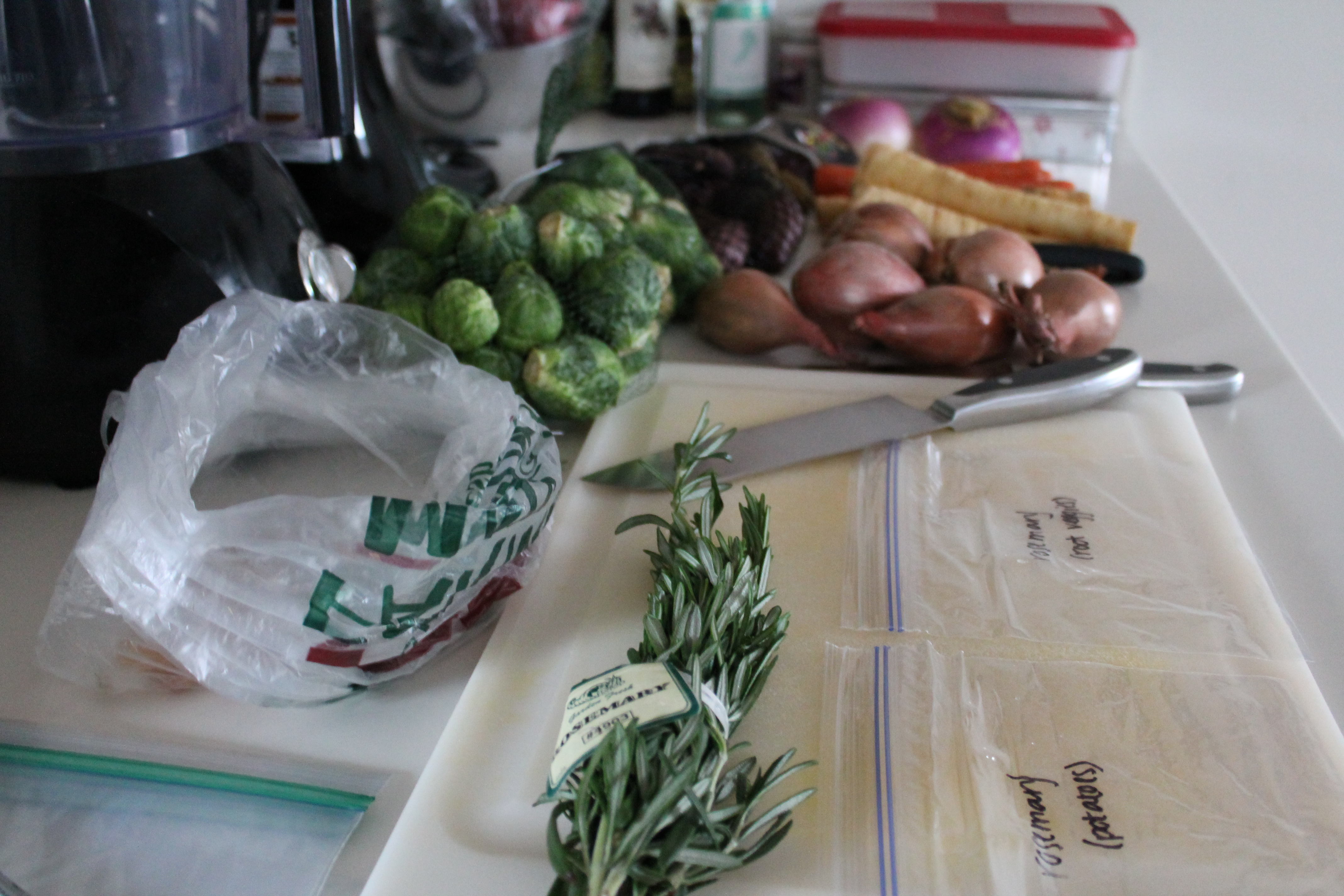 Now (assuming the grocery shopping is done…), gather your main ingredients together. You probably won’t need everything. The goal is to do all the chopping ahead of time, and to make any sauces or marinades ahead of time. It would also be great to prepare breads, stuffings, and desserts the day before the feast (leftover is not a dirty word here!), but that’s now what we are about right now. I like to think of the main day as assembly-only. I just want to be combining ingredients I’ve already prepared, throwing them into a pot or the oven, and stirring. Nothing more.
Now (assuming the grocery shopping is done…), gather your main ingredients together. You probably won’t need everything. The goal is to do all the chopping ahead of time, and to make any sauces or marinades ahead of time. It would also be great to prepare breads, stuffings, and desserts the day before the feast (leftover is not a dirty word here!), but that’s now what we are about right now. I like to think of the main day as assembly-only. I just want to be combining ingredients I’ve already prepared, throwing them into a pot or the oven, and stirring. Nothing more.
Set up your workspace however you’d prefer! Don’t forget some key elements: cutting board(s), your favorite sharpened knife, a bag for compost/scraps, a few towels, a vegetable peeler, and of course, storage bags. Labeled storage bags! Very carefully labeled storage bags!
Here’s why you had to read the recipes ahead of time. If multiple ingredients for one dish are all cooking at the same time in the same way, then you can bag them together! Otherwise, you should store each ingredient separately. And don’t forget, if you need the same ingredient for multiple dishes, you should use a separate bag or container for each one—because it would stink to accidentally dump in three times the amount of garlic needed in one recipe, leaving no more garlic for the other two dishes that call for it.
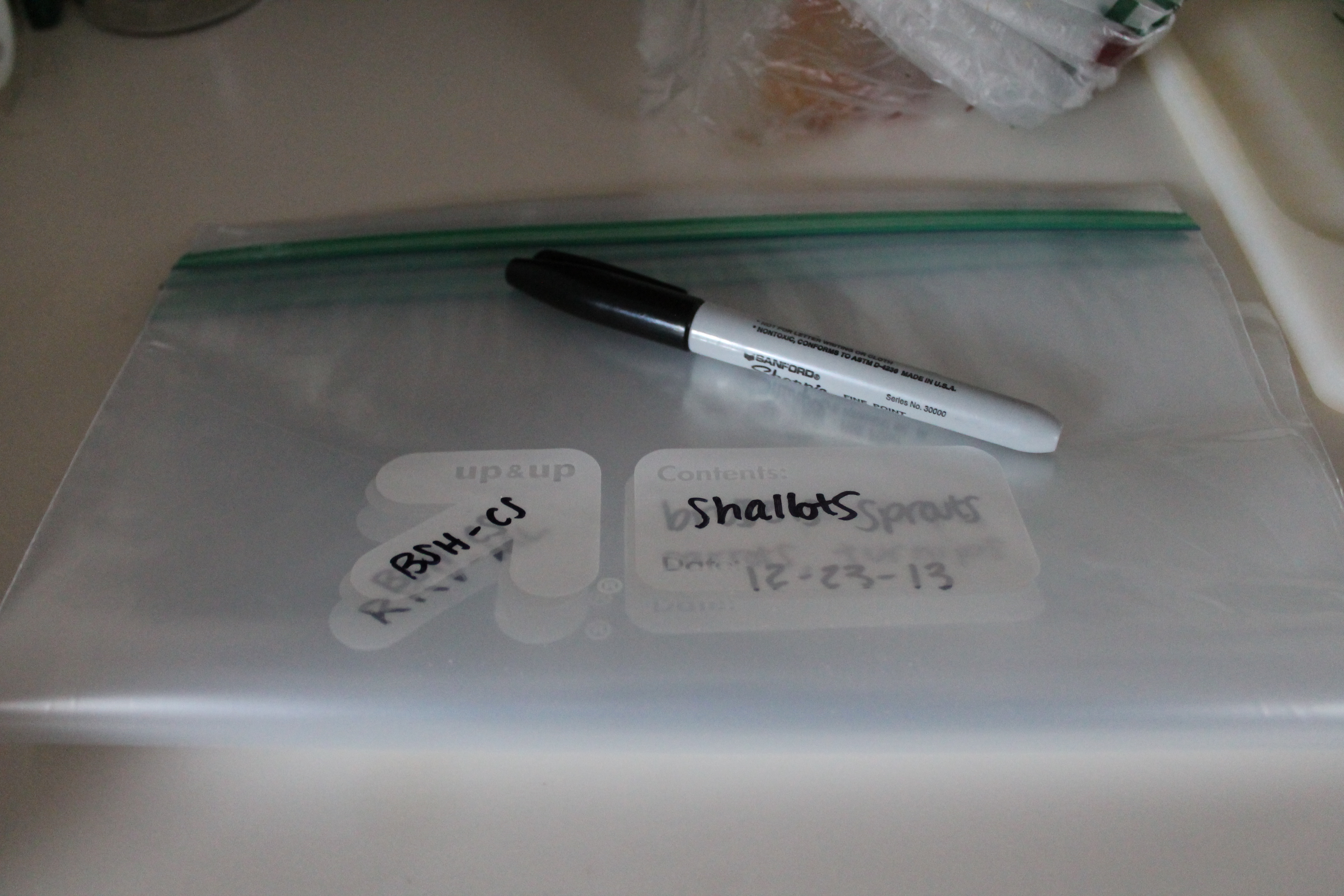 Label meticulously. Even if you think something is obvious now, you don’t want to be scratching your head wondering what it is when you have four other dishes already cooking. I like to label exactly what is in the bag (and how much, if the same ingredient spans multiple bags or if you are making a double or triple recipe), when the bag was packed, and what dish the ingredient is aimed for. If you want to get really precise, you can also mark in pencil on the recipes themselves what prep bags there should be for each dish, that way you know later that there are two bags in the fridge for your brussels sprouts dish, but only one bag of root veggies.
Label meticulously. Even if you think something is obvious now, you don’t want to be scratching your head wondering what it is when you have four other dishes already cooking. I like to label exactly what is in the bag (and how much, if the same ingredient spans multiple bags or if you are making a double or triple recipe), when the bag was packed, and what dish the ingredient is aimed for. If you want to get really precise, you can also mark in pencil on the recipes themselves what prep bags there should be for each dish, that way you know later that there are two bags in the fridge for your brussels sprouts dish, but only one bag of root veggies.
(Of course, if you look closely at my photos, you may notice that I accidentally bagged my brussels sprouts in the shallots bag, and vice versa. I thought about fixing it, but then decided if I couldn’t tell those two things apart, I had much bigger problems.)
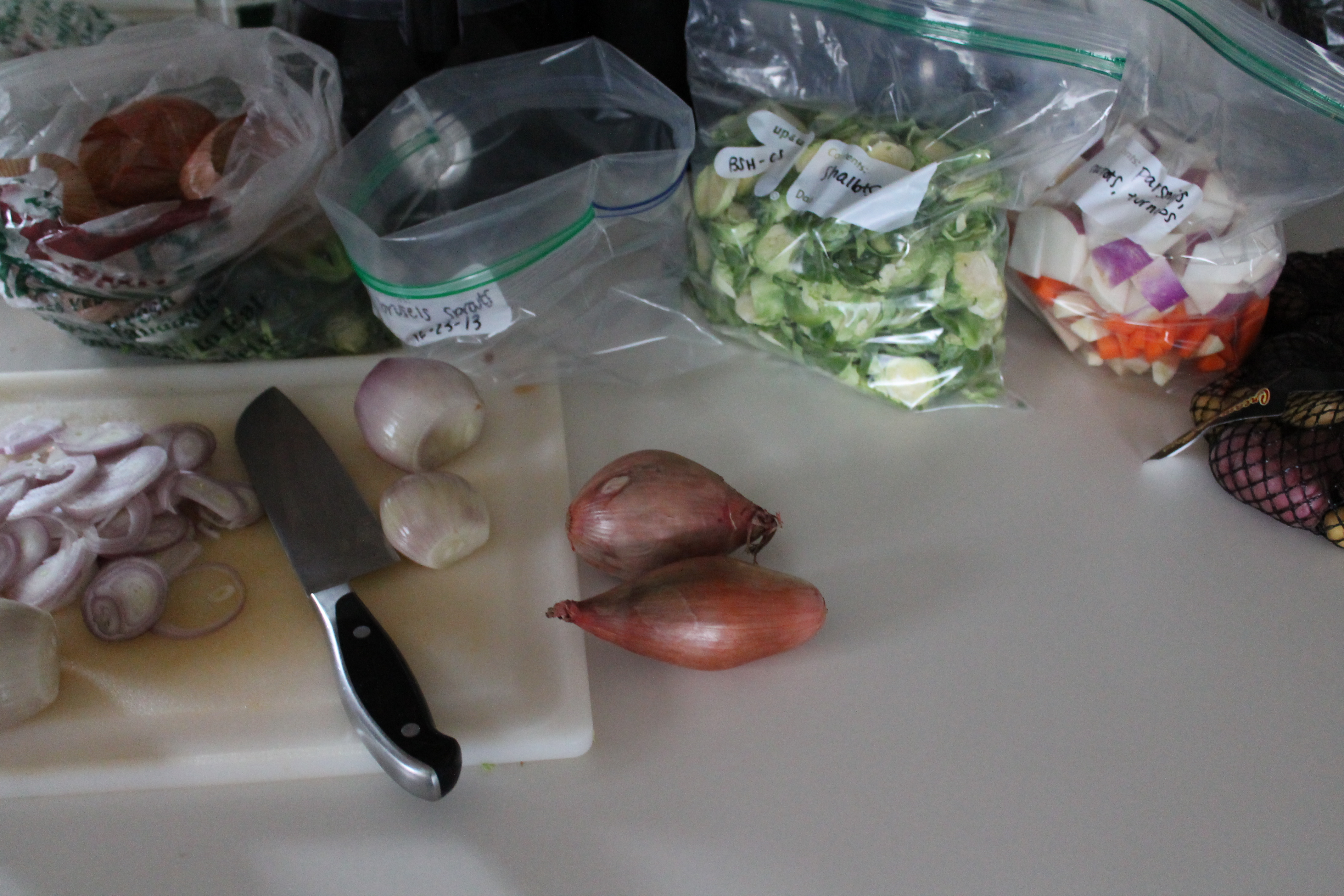 Let’s get down to business. But be cool about it! This part doesn’t have to be stressful, either. You can do it during naptime, or after work. Whenever. And it doesn’t have to be done all at once! If you are working far in advance, you can freeze almost anything that you will be cooking later.
Let’s get down to business. But be cool about it! This part doesn’t have to be stressful, either. You can do it during naptime, or after work. Whenever. And it doesn’t have to be done all at once! If you are working far in advance, you can freeze almost anything that you will be cooking later.
So take your time, have a drink (wine, coffee, cider…whatever!), watch a movie on your laptop or tablet while you work. Don’t forget to wash your veggies and herbs, even those that don’t need to be chopped. One less thing to do later.
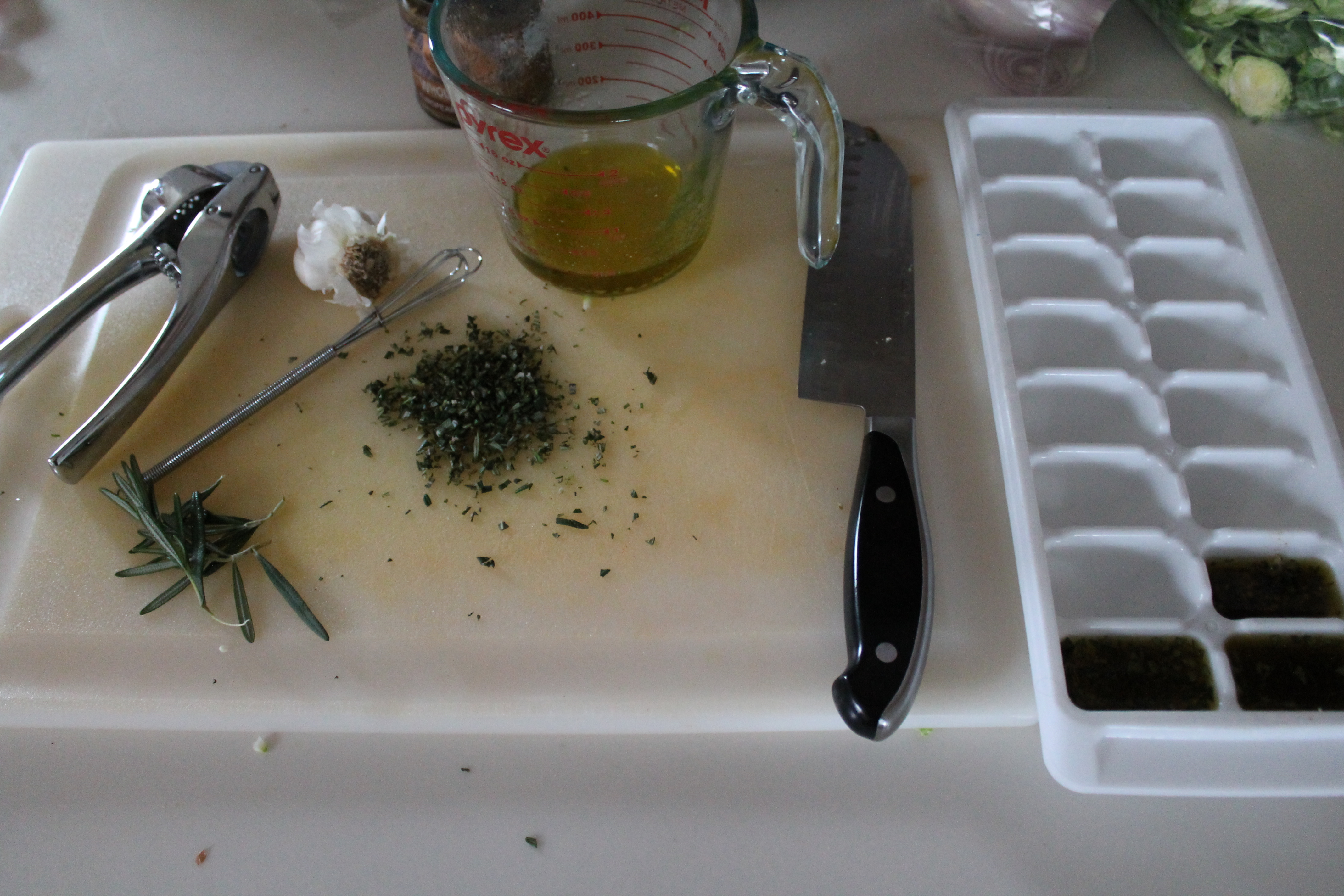 Let’s talk about herbs. Herbs wilt quickly. I only recommend chopping herbs ahead of time if you can freeze them–in olive oil or as part of a sauce is best! Otherwise (like if your herbs are garnish, or should be stirred in dry), you may just want to set aside the amount you will need and plan to chop while other parts of your meal are cooking. I made my herby oils for the roasted potatoes and the roasted root veggies and poured them into an ice cube tray! For the big day, I just need to pop the cubes out and let them thaw. No need to worry about whether each cube is identical, because it will all get mixed back together as it thaws.
Let’s talk about herbs. Herbs wilt quickly. I only recommend chopping herbs ahead of time if you can freeze them–in olive oil or as part of a sauce is best! Otherwise (like if your herbs are garnish, or should be stirred in dry), you may just want to set aside the amount you will need and plan to chop while other parts of your meal are cooking. I made my herby oils for the roasted potatoes and the roasted root veggies and poured them into an ice cube tray! For the big day, I just need to pop the cubes out and let them thaw. No need to worry about whether each cube is identical, because it will all get mixed back together as it thaws.
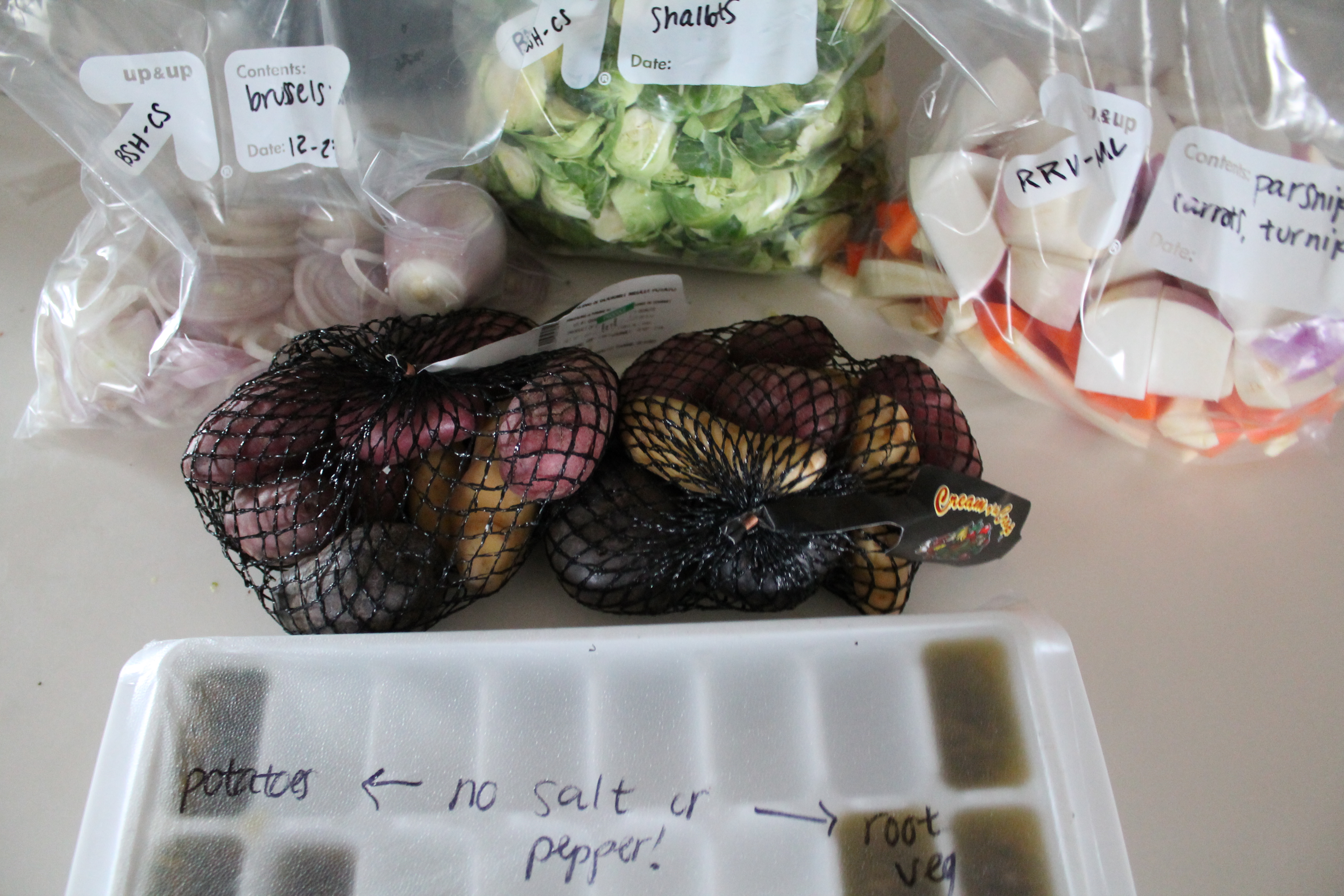 Look! Look what we did! In just a little over an hour, we prepped all the veggies for Christmas dinner!
Look! Look what we did! In just a little over an hour, we prepped all the veggies for Christmas dinner!
That’s a whole hour to spend reading with your kids or napping or playing new video games on Christmas day! Hooray!
One final way to save brainpower and lower stress when you are making a big meal is to write out a schedule for the final day. That may seem overly finicky…but trust me, you will thank me later. Like when you actually remember to take a shower before your family arrives, because you wrote it down in between “shape rolls” and “roast vegetables.” Or, you can build in play times while various dishes are in the oven! It’s just nice to know that you haven’t forgotten anything, and that everything will make it through the oven, all because you planned ahead.
So. All of this might seem like a lot of work. But you already signed up for that, right? When you decided to make a special feast in the first place? For me, assembly-only holidays is the best, most fun way to eat a delicious meal from scratch. And I think you’ll be glad you did this, too.
Merry Christmas!
- One year ago: Hazelnut Kisses
- Two years ago: Portabella Burgers

